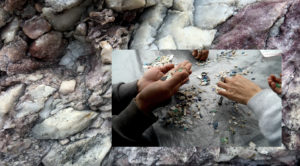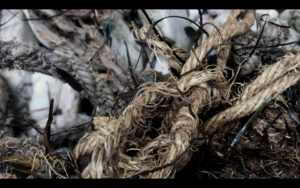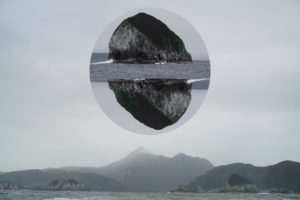Isolation?
Selena de Carvalho describes herself as ‘artist•designer•maker•risktaker’. She is also a Wildcare volunteer who, whilst the world was beginning to respond to COVID-19, spent March autumn days on the South West Marine Debris Clean Up scouring the coastline of lutruwita (Tasmania) alongside other Coastal Custodians removing rubbish from the beaches, bays and inlets – none the wiser.
Below are excerpts from an article she wrote, reflecting on the experience. You can see the full article here.
When you cross a border nothing changes, because you’re still in the same territory, and everything changes because you are in a whole other cosmology and economy.
-39 Steps across the Border and Back, Rebecca Solnit (2005)
Nestled in the stunning rocky enclave of a white sand beach, I nibble fresh seaweed pearls, none here but us, the privilege of setting foot on this remote coast sinking in between my soft, town shod toes. Crawling in the elbow crease of beach and dunes, looking for shards of modernity, waist deep in the visceral quality of remote isolation. Along the edge of an inlet I collect tiny plastic fragments the scale of native cherries. I carefully peel tender plastic bags on the brink of collapse, from shallow graves, tease out fragile, submerged, sand filled membranes. Proof of the far reaching industrial tendrils, these distant West Coast shorelines of lutruwita (Tasmania) are sprinkled with chips of smooth tumble worn plastic, the vibrant colour turquoise screaming foreign entity.
I sense myself reluctantly, authentically slowing down. Arriving. When are we truly present? How slow do I have to be to develop this rubbish mindset?
The smell of decaying kelp hits my nostrils, held in this tight gulch of a corner, decomposition is in full swing. Winding through iodine rich mounds, a small tannin stained creek cuts a trail. Plastic mingles with the rot.
Acclimating to the sensorial overwhelm, each spot is sprinkled in plastic 100’s and 1000’s, I pick away… shuffling ever so slightly when the debris supply has been exhausted.
Nanoplastics can cross both cellular membranes and the blood-brain barrier.[i]
[i] Lubofsky, Evan. Particles on the Move Studying the spread of nanoplastics inside fish (Woods Hole Oceanographic Institution) March 7, 2019. Source:
https://www.whoi.edu/oceanus/feature/particles-on-the-move/
Plastics are chemical combinations that didn’t evolve alongside the detritus of life, their human engineered composition resists deterioration, such that microbial-scavengers of decay have to play catch up. Some time between 2010-15 a tiny organism known as Ideonella sakaiensis evolved in Sakai, Japan, and figured out how to breakdown and use plastic for energy. This rare, new form of life grew out of the glut, a mutant borne of the toxic soil surrounding a recycling plant, this new babe of a microbe, surely cannot proliferate to digest our overabundance?
Diving like seagulls we count the rubbish on deck, scrounging for the remnants of a humanity that has forgotten its ecological interdependence. Unhooked from the news, the shows, the updates, the discovery of a nurdle becomes tabloid. Bags of rope, lurid fluro containers, shards of glass, tokens of plastic, netting, fragments of polystyrene, everything reeks of overwhelming futility, and yet, simultaneously feels purposeful.
How do we care for places, not just technically?
Together, apart, heads craned forward, our slow moving zombie-esk gang looks to the ground, scrutinising this apparently pristine place, the rubbish of millions on the shores of few. Two beaches separated by a headland, a conglomerate of pink rose quartz that fades into cream, a lake behind the dunes, a seam of garnets, petrol shiny middens[i] of snail shells, crags of abalone, a seal skull, spiral twisted bonsai climb the dunes. Only the most elegant of traces remain. Stone tools set in place, seemingly with the confidence of an imminent return. Time stands still.
[i] A ‘midden’ is an occupation site where Aboriginal people left the remains of their meals. At some sites substantial deposits grew over generations of use of the same area. Source: https://www.creativespirits.info/aboriginalculture/land/guide-to-aboriginal-sites-and-places
Is country laughing at me, in my plastic shoes, and plastic rain-jacket, my fancy phone and plastic bag in hand, examining the sand for hours, picking up pieces of plastic the size of my fingernail? Plastic promiscuously cruising the globe, transporting toxic bacteria surfing international tides, bacteria that are capable of causing coral bleaching, and triggering wound infections in humans. Hyperobjects vastly distributed through time and space, riding the currents of large ocean gyres, no regard for political boundaries… another transnational movement like migratory birds, drifting pollutants, changing weather and pandemics, so widespread in their reach and web of affect.
This changing place is full of ghosts, of histories, country that I will forever be a visitor. The profound sensation of remoteness and isolation is intrinsically linked to colonisation, to the trauma of Aboriginal people. I feel the debt that other bodies have paid for me to walk this line. I want to re-arrange time.
We get pulled into several dry creek beds as clusters of sticky smeg collect in the cul-de-sac of tributaries. Someone pulls a rats tail of rope resting on the surface, the sands birth a sleazy orgy of metal cable, faded ropes of all colours and textures knotted together, pieces of steel railing, a giant caterpillar cocoon post-industrial dread lock.
The uncomfortable presence of absence, a gaping hole in the sand that will be smooth after the next high tide, washed away with our footsteps.
The web of the internet catches us before we reach land.
News on repeat, cruise ships reeling with COVID19, a different regime, new rules and governance, we play catch up after having dropped out of what felt like a significant moment in the unfurling of this tragic time.


